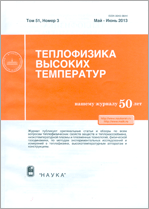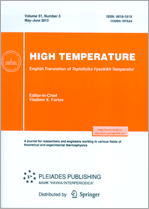|
|
Teplofizika vysokikh temperatur, 2000, Volume 38, Issue 3, Pages 381–385
(Mi tvt2098)
|
 |
|
 |
This article is cited in 6 scientific papers (total in 6 papers)
Plasma Investigations
The structure of nonequilibrium electrode microwave discharge in nitrogen
Yu. A. Lebedev, M. V. Mokeev
A. V. Topchiev Institute of Petrochemical Synthesis, Russian Academy of Sciences, Moscow
Abstract:
The structure of an electrode microwave discharge in nitrogen at a pressure of $1$ torr and incident power of up to $500$ W is studied by the optical and probe methods, when the size of the plasma formation is much less than the size of the discharge chamber. It is shown that the discharge has a spherical structure and a bright glowing film near the electrode surface. This coincides with the structure obtained in a discharge in hydrogen. The observed differences, in particular, a more symmetric shape of the discharge relative to the electrode end, may be due to the different mechanisms of ionization and excitation of discharges in hydrogen and nitrogen. In nitrogen, the role of excited particles is significant, which results in a possibility of existence of a discharge in lower fields. The measurements with a double probe have shown that the voltage-current characteristic is shifted along the voltage axis and passes through zero current at nonzero voltage. This may be interpreted as the presence of constant fields in the plasma. This shift slightly depends on the radial position of the probe in the discharge, decreases drastically on the discharge boundary, and is absent outside of the glowing spherical region of the plasma. The emergence of such fields may be due to the nonlinear interaction of the microwave field with the plasma. The constant field may prove to be a determining factor in the formation of a spherical structure. Spherical structures are known to form when a dc voltage is applied to the electrodes in the plasma. The measurements of the potential difference between the antenna and the probe placed in the plasma have shown that this potential difference is of the order of $kT_e$ and weakly grows with an increase of incident power. This explains the absence of intensive ionic bombardment and electrode sputtering in the microwave discharge plasma.
Received: 06.07.1999
Citation:
Yu. A. Lebedev, M. V. Mokeev, “The structure of nonequilibrium electrode microwave discharge in nitrogen”, TVT, 38:3 (2000), 381–385; High Temperature, 38:3 (2000), 358–362
Linking options:
https://www.mathnet.ru/eng/tvt2098 https://www.mathnet.ru/eng/tvt/v38/i3/p381
|


| Statistics & downloads: |
| Abstract page: | 195 | | Full-text PDF : | 86 |
|





 Contact us:
Contact us: Terms of Use
Terms of Use
 Registration to the website
Registration to the website Logotypes
Logotypes








 Citation in format
Citation in format 
